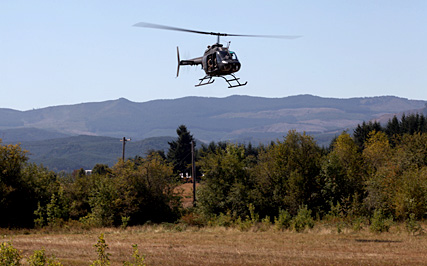Tribal Government & News
Tribe aids effort to weed out marijuana grow sites

At 11 a.m. on a sunny Thursday, National Guard helicopters landed
on a patch of grass in front of the Tribal Natural Resources
Department building like it's a M.A.S.H. unit, but the whirlybirds
were not bringing in the wounded.
They are part of a multi-agency drug team, back from the first of
two flights scheduled for the day, searching for large-scale
marijuana growing sites.
This year, for the first time, the operation for the four
northwestern counties started and ended on Tribal property in Grand
Ronde.
"We're a certified law enforcement agency," says Director of
Development and Public Safety Pete Wakeland, "so it makes sense
that we cooperate with other law enforcement agencies. It's a
combined effort to keep the Reservation and local community
safe."
Making Tribal property available to the team started with a request
from Oregon State Police Senior Trooper Randy Ogle to Tribal
Interim Police Chief Jake McKnight. They have worked together for
years -- Ogle as coordinator of the Coast Region Marijuana Team and
McKnight as the Tribe's Forest Patrol officer.
"Whatever I can do to make it easier on them, I'll lend a
hand," says McKnight.
Ultimately, Natural Resources Manager Michael Wilson recommended
the Tribe participate and Wakeland approved it.
The annual flyovers bring together Oregon State Police, sheriff
deputies from Yamhill, Polk, Lincoln and Tillamook counties, staff
members from the Bureau of Land Management, the U.S. Forest Service
and the National Guard to sniff out major marijuana grows in the
region.
Owing to budget cutbacks in recent years, says Ogle, coordinator of
the effort this year and for the last two, "We're only looking for
big grows, from 2,500 to 5,000 plants or more, sometimes up to
10,000 plants.
"We used to have a helicopter for each county, but now we're down
to two helicopters for all four counties."
The majority of grows that the operation has uncovered since the
program began more than 20 years ago, Ogle says, have been
enterprises run by Mexican drug cartels.
"These investigations aim to catch the big fish," he says, "not
just the guys growing the plants. We could process the growers, but
more would be right back tomorrow."
Planning for these annual searches begins as early as March. The
actual flights take place from July 1 through the end of September,
the growing season for marijuana.
Ogle, who has 22 years in law enforcement, says the operation's
first concern is for the public. Bow hunters and hikers may
unwittingly come into a place where growers have guns. On the other
hand, when civilians come upon a grow site, they may report that
site to the police, helping the effort.
To investigate up the line, police are looking for people who are
not likely in the area, but are nevertheless running and funding
the operations. At the same time, they need to complete the work on
a discovered site before the marijuana is harvested to prevent it
from reaching the street.
Each of the four counties involved in this region ¬¬-- similar
operations take place across the state -- receive about 10 hours of
helicopter coverage over two days. Each helicopter is staffed by a
pilot and one or two marijuana spotters.
The spotters work with naked eyes because using binoculars causes
dizziness. Many veterans, like Ogle, know where to look. They have
extensive experience with the area after years of operations.
"We have historic grow locations," says Ogle, "and with fewer
resources, we focus on these areas."
Just as the police know a lot about growing operations and places,
growers also know a lot about police operations.
"It's kind of a cat-and-mouse game," says Ogle. "We try to adapt
our operations based on what they know, and they try to adapt their
operations taking into consideration what we know."
"The easiest way to find a grow," says one of those involved, "is
to look for the green and blue Miracle-Gro fertilizer bags."
The mess left behind at these growing operations is a
signature.
"They do all sorts of environmental damage," Ogle says. "They dam
up the creeks, leave fertilizers and trash all around." Sometimes,
they dig holes to pile it all in, but they don't bother covering
the trash sites, leaving animals to scatter the garbage. They limb
and dig up trees and set the stage for extensive erosion.
"I've seen the fertilizer and all the garbage they leave behind,"
says McKnight. "That was always a pet peeve of mine when I was
Forest Patrol officer."
As a result of grow operations, private forest landowners who have
allowed hunters and hikers to use their land for recreation in the
past have stopped doing so.
Twenty-some police and administrative personnel who make up the
Coast Region Marijuana Team are sometimes barely enough to do the
investigation once a grow operation is spotted, Ogle says.
"You need a lot of resources to investigate," he says.
Some of the sites are behind steep and forbidding terrain, so in
addition to the risk of violence they face, police also prepare for
less dramatic risks, such as heat exhaustion.
Opening up Tribal property for the operation made the work
easier.
"It's a great area and it really has helped us out," Ogle
says.
Coastal airports have fog issues and the Tribal land is central to
the counties involved, Ogle says.
As the helicopters settle down in front of the Natural Resources
building late that morning and the propellers slow, a National
Guard truck moves in for refueling.
"It's good to see that we're all working together," Ogle
adds.
To provide information about possible marijuana grow sites, contact
the Yamhill County Inter Agency Narcotics Team at 503-472-6565.
